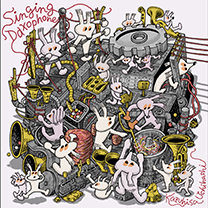December 28, 2021
Singing Daxophone - Kazuhisa Uchihashi
 Label: Innocent Records (bandcamp)
Label: Innocent Records (bandcamp)
Catalog #: icr-025
Location: Japan/Germany
Release Date: November 22, 2021
Media: cd or digital download
bandcamp.com entry
discogs.com entry
Let us begin this review with a little background. Hans Reichel (May 10, 1949 - November 22, 2011) invented the daxophone, an instrument which could be manipulated to create the sounds of a tuba, a violin or a badger, among many others. While the daxophone made appearances on various recordings by Reichel, his music with the instrument is high-lighted best on his two daxophone operettas, Shanghaied on Tor Road (FMP, CD 46, 1992, cd) and Yuxo (a|l|l, 003, 2002, cd).
Kazuhisa Uchihashi and Hans Reichel were long-time collaborators. We provided a relevant summary of their daxophone related collaborations in our review of saxophonedaxophone (Doubtmusic, 2015) by Junji Hirose and Kazuhisa Uchihashi. We direct the interested reader to that somewhat expansive and retrospective review, written July 28, 2016. As the duo with Junji Hirose demonstrates, Uchihashi has continued to perform with the daxophone in various collaborations.
The tradition of solo daxophone performances did not re-emerge until the release of Talking Daxophone (Innocent Records, 2017), in which Uchihashi presents careful non-idiomatic improvisations on the daxophone. This record is, at the same time, an honest homage to Reichel, as well as an independent testament of the sonic abilities of the instrument. Talking Daxophone contains primarily single track recordings, in which one instance of the instrument is played in a live, continuous take. The shrieks and ululations are genuine and unedited. In the twenty-seven original compositions, the sounds are sometimes musical and often dissonant. At the time of the release of Talking Daxophone, Uchihashi let it be known that a companion album, Singing Daxophone was in the works. So now we come to the matter at hand.
While Singing Daxophone and Talking Daxophone possess two important similarities—namely Uchihashi and the daxophone—they are otherwise as different as night and day. Like Shanghaied on Tor Road and Yuxo, Singing Daxophone contains multi-tracked daxophone, in which different sticks are overlaid and employed to give rise to a chorus of voices, some providing rhythm and others melody. To our great surprise, the album contains thirteen covers of very popular songs, almost all of which are immediately recognizable by both title and tune. The renditions are faithful, or as faithful as can be achieved given that all instruments and voices are replaced by daxophone! Each song is dedicated to the composer and we reproduce the list here:
- James Brown / I Got You (I Feel Good)
- Burt Bacharach / (They Long to Be) Close to You
- Lou Reed / Walk on the Wild Side
- Freddie Mercury / Killer Queen
- David Bowie / Space Oddity
- John Paul Jones, Jimmy Page & Robert Page / Black Dog
- John Lennon & Paul McCartney / Eleanor Rigby
- Percy Mayfield / Hit The Road Jack
- Brigitte Fontaine, Areski Belkacem / Comme á la Radio
- Nameless Italian Partisan who fought back for the peace / Bella Ciao
- Paul Simon & Art Garfunkel, and unknown Folk Singers / Scarborough Fair
- Vincent Ford / No Woman, No Cry
- George David Weiss / What a Wonderful World
Singing Daxophone is an album utterly unlike any previous daxophone album. There is no precedent whatsoever for the juxtaposition of the alien sound of the instrument with the familiar tunes. When we first heard the daxophone on Shanghaied on Tor Road in 1992, we were transported by its unique and other-worldly sound. Singing Daxophone rekindles that feeling of never having heard anything remotely like it. This kind of innovative musical exploration doesn't happen every day or every year or even every decade! It seems unlikely that there will come again another daxophone masterpiece to equal this. We can say little more except to urge curious listeners to seek out the recording. For uncertain ears, this is inarguably the easiest access point to discovering the daxophone.
The daxophone is an idiophone, a term which implies that each instance of the instrument possesses a unique sound. The choice of sticks for each tune is an essential artistic decision for the ultimate sound of the song. Moreover, the ornately cut sticks do not lend themselves easily to traditional notes. A tiny errant stroke of the bow can shift the sound from high-pitched whistle to bellowing tuba. Finding (and reliably reproducing) the hidden sweet spots on a stick requires tremendous time and, we speculate, multiple takes. The clean and melodic sound of these songs is unmistakably the fruit of Uchihashi's perseverance and dedication.
Singing Daxophone was released on the tenth anniversary of Hans Reichel's death. It captures the artistry and humor that Reichel embraced and serves as a fitting memorial. In a related note, Uchihashi also reissued Reichel's Yuxo on Innocent Records on the same day.
personnel:

